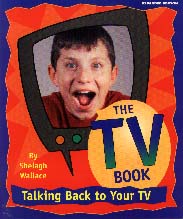|
________________
CM . . . .
Volume V Number 19 . . . . May 21, 1999
excerpt: Advertisers often spend more creating a commercial that lasts one minute than TV producers spend making a half-hour show. Between 20 and 40 percent of a product's price goes to pay for the cost of advertising it, including the commercials. So if you buy a toy that costs $29.95, between $6 and $12 of your money goes to telling you and others about it!As kids today spend such a great amount of time watching television - their TV viewing hours often exceed the number of hours they spend in school - it is absolutely imperative that they become more critical viewers. The TV Book, updated from the 1996 version, takes readers behind the scenes of television programs for a closer look at casting, programming, special effects, TV violence, viewing patterns and commercial sponsorship. Interviews - with a casting director, a stunt man, an owner of a research company that tests kids' TV shows, and two young teens, who, for a science fair project, duplicated experiments which they saw on commercials - add a human touch. Rather than simply presenting information, the book asks readers to think about certain aspects of their TV viewing and gives examples of how creators of television shows get viewers to see exactly what they want them to see. It includes short quizzes designed to reinforce some of the ideas presented. Most importantly, however, the book spurs kids on to social action, providing names and addresses of organizations to which kids can write if they want to voice their complaints about an ad, an overly violent TV program or about the cancellation of a favourite sitcom. It is the author's belief that the critical skills acquired by students through reading this book will also be applied to other media forms, such as the Internet. The book is divided into several sections whose topics range from the creation of a TV series to infomercials. Occassionally, TV tidbits -interesting trivia - are presented within gray-coloured circles. Quizzes and other information appear on vivid yellow backgrounds. If there is one drawback of this book, it is that these yellow areas are not positioned as sidebars or at the end of a segment. Rather, they interrupt the flow of the text, causing readers to either abandon the paragraph they are reading in order to glance at the "extra" info, or to continue reading the next few pages and then backtrack. In fact, in one of these yellow sections, there is a glaring omission. Beneath the bio of Lynne Miller, a casting director, the text stops abruptly without completing the sentence. For the most part, the text is written in kids' language, though younger students might have a bit of difficulty with some of the vocabulary. With the exception of black-and-white photographs of the interviewees featured in the book, the illustrations are brightly coloured cartoon drawings, some with a collage effect employing intricate patterns and designs. Attractive and eye-catching, these illustrations will appeal to both elementary and junior high students. Also provided are several pages of "tele-wise" words (actually a glossary with very thorough explanations of the entry words), a section on public TV, networks and Canadian and American broadcasting codes, and a list of names and addresses of TV-related organizations with a brief description of each. Activities designed to help students learn more about the topics and issues covered in the book offer abundant, varied ideas which range from the simple to the complex. Some of them can be done in a few minutes, while others require long-term study. A list of resources and an index are also included. Informative and often enlightening, The TV Book is an excellent resource for teachers who are planning a unit on critical television viewing. Highly Recommended. Gail Hamilton is a teacher-librarian at Bird's Hill School in East St. Paul, MB.
To comment on this title or this review, send mail to cm@umanitoba.ca.
Copyright © the Manitoba Library Association.
Reproduction for personal use is permitted only if this copyright notice
is maintained. Any other reproduction is prohibited without
permission.
Published by
TABLE OF CONTENTS FOR THIS ISSUE - MAY 21,
1999.
AUTHORS |
TITLES |
MEDIA REVIEWS |
PROFILES |
BACK ISSUES |
SEARCH |
CMARCHIVE |
HOME
|

